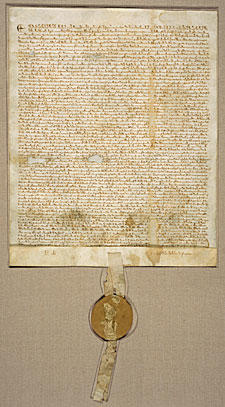
Fabrication specialists at the National Institute of Standards and Technology (NIST) are joining forces with conservators at the National Archives and Records Administration (NARA) to protect and display a document that influenced our nation's foundation, the 1297 Magna Carta. Only four originals of the 1297 Magna Carta survive, and the one at the Archives is the only original on display in the United States.
The famous charter is on exhibit in the West Rotunda Gallery in the National Archives Building on Pennsylvania Avenue in Washington, D.C.
The Magna Carta harkens back to 1215 when King John of England was forced by an assembly of barons to write down the traditional rights of the country's free persons. By so doing, he bound himself and his heirs to grant "to all freemen of our kingdom" the rights and liberties described in the great charter, or Magna Carta. Each subsequent ruler did the same. The 1297 Magna Carta represents the transition from a brokered agreement to the foundation of English law, upon which U.S. law is based.
NIST has been involved in safeguarding several important historical documents. In 1951, NIST researchers developed and implemented a preservation technique to encase the Charters of Freedom—the Declaration of Independence, the Constitution of the United States and the Bill of Rights—safely in helium-filled cases. . NIST and NARA worked together on a five year project from 1998 to 2003 to create a totally new and updated encasement design for very long-term sealed encasements filled with argon gas. Building on that experience, working with the Library of Congress, NIST manufactured and delivered an encasement in 2007 that was six times larger than those for the Charters of Freedom to protect the 1507 Waldseemüller map, often called "America's Birth Certificate" because it is the first world map to label the lands of the New World as "America."
"Working with the Archives," explained NIST engineer Mark Luce, "we incorporated the latest technology for the encasements to help protect these documents from negative environmental effects and maintain their condition for many years." Like the Charters of Freedom, the Magna Carta will be displayed in an inert gas environment that reduces oxidative degradation and maintains constant moisture content so that the parchment will lie flat and not deteriorate.
The Archives will display the Magna Carta until early 2011 while plans for the new encasement are developed. The document will be withdrawn from display for one year while the new encasement is constructed at NIST, Archives conservators carry out any needed conservation on the document, and it has time to become acclimated to the new encasement environment. A new exhibit is planned to explore the connections between the Magna Carta and the American Declaration of Independence and Constitution so visitors will better understand how this document influenced American freedoms more broadly.

